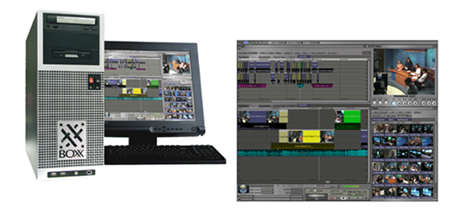
PRICING: VT [3] (without computer) - $2,995
SX-8 option - $1,995
RS8 option - $995
SDI option - $995
Highlights:
- Integrated Broadcast Production Suite
- Includes full version of LightWave 3D 7.5
- Software centric solution
When I was first asked to review NewTek's VT [3], I must admit to some skepticism. To be honest, it's been many years since I really paid much attention to NewTek beyond LightWave 3D. I thought LightWave was the only professional product NewTek had, and presumed anything else they offered (a Toaster or blender or coffee maker or something?) were for the prosumer market. I mention my skepticism and preconceptions to show the initial level of my ignorance as to where NewTek has really evolved with its video technology. As I discovered during my review, the VT [3] is totally new software, based on the spirit of innovation found in NewTek's pioneering work in desktop video, but having evolved into a truly professional tool.
A good out of the box experience
For my review, Paul Lara, NewTek's video evangelist, personally flew out with a system. We operate an SDI video and AES audio facility, so Paul had the proper digital cards installed and we simply pulled out our current NLE system and plugged in the VT [3], hooking it up to our SDI router and network. Because the VT [3] is a Windows-based computer, the connections were simple and took only a few minutes. It worked flawlessly when we turned it on. The system I tested was a 3DBoxx from Boxx Technologies equipped with dual-Intel Xeon 2.8 GHz processors, a 340 GB Ultra 320 SCSI system drive and a 340 GB video drive. Dual processor workstations are highly recommended for the VT [3], as nearly everything it does is software-based.
Much more than a post production box
My initial interest in the VT [3] was primarily in the post production environment, but this is a bit like being interested only in the tires when doing a review of a car. The VT [3] is far more than just a post production suite, as it's also a fully-functioning live video and audio switcher, integrated character generator, digital disk player/recorder, and machine controller. It is in essence a true "TV-studio-in-a-box." The live switcher can be mouse-controlled on screen or experienced technical directors can opt for the RS-8 switcher control surface. Also available as an option is the SX-8 switcher expansion unit for easy patching of up to eight component or 24 composite inputs, which can include different combinations of SDI, composite, component and S-video. Each input has its own internal frame sync, so there's no need to worry about genlock - just plug your sources right in and internally time them. In addition to external inputs, multiple internal digital disk recorders (VT-DDR) can be used during the live production for playback and recording. A playlist can be loaded into the VT-DDRs to follow a show rundown, providing control for video, graphics, still store and titles. I didn't spend a lot of time with the live switching component of the VT [3] other than to see that it could switch between my SDI sources and the internal VT-DDR, and could use complex 3D effects for transitions. Now, on to the main course…
Integrated post production suite
As I mentioned, my knowledge of NewTek was through my familiarity with the widely-used LightWave 3D software. Amazingly, VT [3] comes bundled with the full version of LightWave 3D version 7.5. It also comes with NewTek's video paint and compositing software, Aura Video Paint, which allows for some of the fastest painting over video I've seen. Also included is VT-CG, which is accessible to both the live production and post production environments. It is a modestly but adequately-featured character generator. Finally, VT [3] includes VT- Edit, which is unlike any NLE I've used before.
As Paul Lara explained, "We didn't want to be a clone of any other NLE out there or follow inefficient conventions. We designed it by listening to what editors needed to work more efficiently."
Indeed, VT-Edit is a unique and uniquely powerful editor. One of the first differences I noticed and liked is the ability to have multiple timeline views on the screen at once. One timeline can show the entire program and one can be zoomed in to a very small section. This is great for seeing how a small change fits into the overall program or for cutting and pasting across larger sections very quickly without the hassle of zooming in and out all the time. Also, instead of two timelines you can have one timeline and one storyboard on the screen and quickly jump back and forth between the timeline and storyboard based editing.
Other features I like are VT-Edit's spline-based control of all motion and animation parameters and realtime 3D control of positioning and rotation of layers. Also, like most current top-end NLEs, when an effect or transition is too complex to be played in realtime, VT-Edit renders it in the background so you can keep working. Most importantly, in my mind, is the fact that VT-Edit, LightWave 3D and Aura Paint are integrated together in VT [3]. The digital content creator has access to an incredible creative toolbox in one tightly-integrated system.
Is VT [3] for real?
NewTek started the desktop video revolution, and with VT [3] it seems they've created a powerful tool for continuing that revolution.